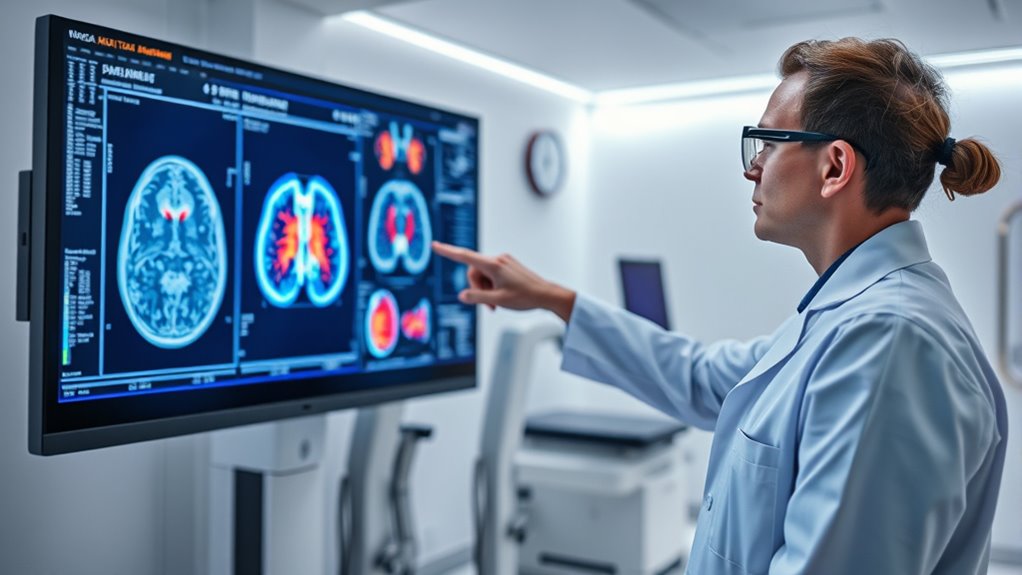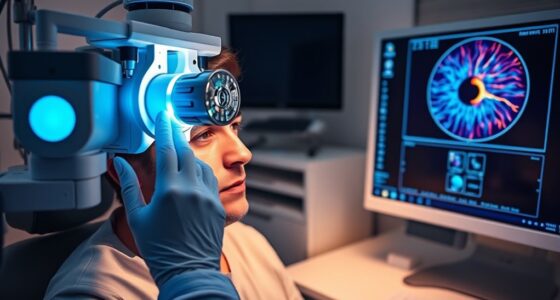AI diagnostics use machine learning to analyze various medical scans like MRIs, CTs, and ultrasounds quickly and accurately. The process involves training models with large, annotated datasets so they can detect abnormalities such as tumors or injuries. Complex algorithms like CNNs and U-Nets help recognize patterns and segment images. This technology improves diagnosis speed and precision, but challenges remain. Keep exploring to understand how these tools are transforming healthcare and what the future holds.
Key Takeaways
- Machine learning analyzes medical scans like MRI, CT, ultrasound, and X-rays to detect abnormalities such as tumors or lesions.
- AI models are trained on large, labeled datasets to recognize specific features and improve diagnostic accuracy.
- Advanced algorithms like CNNs and U-Nets identify patterns and segment structures within scans for detailed analysis.
- The process involves validation and testing to ensure AI models reliably generalize to real-world clinical images.
- AI enhances diagnostic speed and precision, supporting early detection and personalized treatment decisions.
Understanding Machine Learning in Healthcare
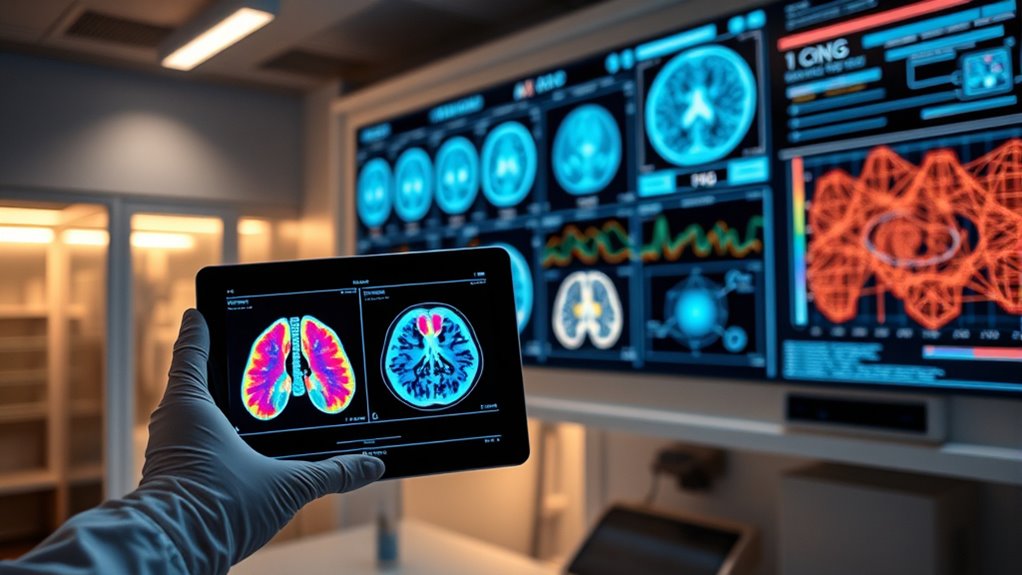
Machine learning is transforming healthcare by enabling computers to analyze vast amounts of medical data and identify patterns that humans might miss. You can think of it as teaching machines to learn from examples, improving their ability to make predictions or decisions. Instead of relying solely on human intuition, machine learning models sift through clinical records, lab results, and imaging data to find insights that support diagnoses. These algorithms adapt as they process more information, becoming more accurate over time. This technology accelerates diagnosis processes, reduces errors, and helps identify diseases earlier. By automating routine tasks, it frees up healthcare professionals to focus on patient care. Fundamentally, machine learning acts as a powerful assistant, enhancing your ability to deliver precise, personalized treatments. Additionally, the use of high-quality training data ensures that these models perform reliably and accurately across diverse patient populations.
Types of Medical Scans Analyzed by AI
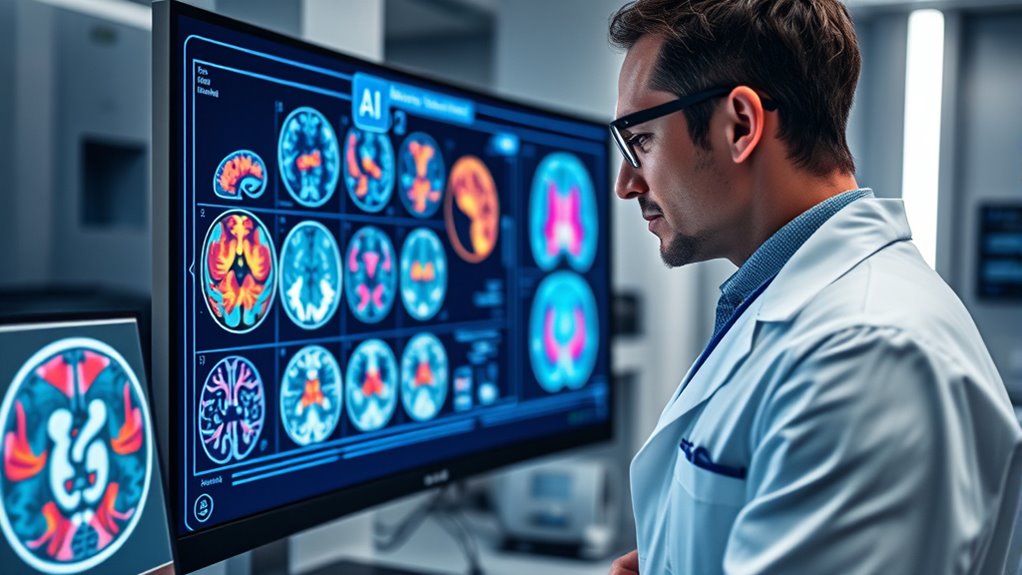
AI analyzes a variety of medical scans, including MRI, CT, and ultrasound, to detect issues quickly and accurately. It also processes X-rays and PET scans, providing detailed insights for diagnosis. Additionally, specialized imaging techniques help uncover conditions that might be missed with standard scans. Incorporating the latest advanced technology ensures even greater accuracy and efficiency in diagnostics.
MRI, CT, and Ultrasound
Have you ever wondered how advanced algorithms are transforming medical imaging? AI now plays a vital role in analyzing MRI, CT, and ultrasound scans. These imaging techniques produce detailed pictures of your body’s internal structures, helping doctors detect issues early. AI algorithms swiftly process these images, highlighting abnormalities like tumors, lesions, or organ damage that might be hard to spot manually. For MRI and CT scans, machine learning models improve accuracy by reducing false positives and negatives. Ultrasound images, often more challenging to interpret, benefit from AI’s ability to enhance clarity and identify subtle patterns. By automating the initial analysis, AI speeds up diagnoses, increases precision, and supports doctors in making more informed decisions, ultimately improving patient outcomes.
X-Rays and PET Scans
X-rays and PET scans are essential tools in medical diagnostics, and advanced algorithms are now enhancing their analysis. AI systems can quickly identify abnormalities such as fractures, tumors, or infections by examining X-ray images with high accuracy. They learn to differentiate normal tissue from pathological signs, reducing diagnostic errors and speeding up decision-making. PET scans, which reveal metabolic activity, benefit from AI by detecting early signs of cancer or neurological issues that might be subtle for the human eye. Machine learning models analyze complex patterns in these images, providing radiologists with valuable insights. This integration streamlines workflows, improves accuracy, and helps clinicians deliver faster, more precise diagnoses. As AI continues evolving, its role in interpreting X-rays and PET scans becomes increasingly crucial for patient care.
Specialized Imaging Techniques
Building on the advancements in analyzing X-ray and PET scan images, specialized imaging techniques like MRI, CT, and ultrasound are increasingly being integrated with AI. These technologies allow you to detect subtle abnormalities that might be missed by the human eye. AI algorithms analyze MRI scans to identify tumors, brain injuries, or multiple sclerosis signs with high accuracy. CT scans, combined with machine learning, help you quickly pinpoint fractures, blood clots, or internal bleeding. Ultrasound imaging benefits from AI by improving fetal monitoring, detecting cysts, or diagnosing organ issues in real-time. By leveraging AI, you enhance your ability to interpret complex data, reduce diagnostic time, and increase precision. These specialized techniques are transforming medical diagnostics, making early detection more accessible and reliable. As a result, medical diagnostics are becoming more precise and accessible through ongoing technological integration.
How AI Models Are Trained to Interpret Scans

You’ll see that training AI models involves gathering extensive data from various scans using specific collection techniques. Next, the models learn through structured training processes that modify their algorithms based on this data. Finally, they are validated and tested to guarantee accurate interpretation before being deployed in real medical settings. As AI continues to evolve, integrating advanced processing power will further enhance diagnostic accuracy and efficiency.
Data Collection Techniques
To train AI models to interpret scans effectively, developers rely on collecting vast amounts of labeled imaging data. They gather images from hospitals, research institutions, and public databases, ensuring a diverse range of cases and conditions. This data must be accurately annotated by medical experts who identify and label specific features, such as tumors or fractures. Data collection also involves anonymizing patient information to protect privacy and comply with regulations. Sometimes, synthetic data generated through techniques like data augmentation helps expand datasets and improve model robustness. Additionally, data quality is critical for ensuring the accuracy and reliability of diagnostic results. By sourcing high-quality, well-labeled images, you give your AI the foundation it needs to learn patterns and make accurate diagnoses. This meticulous collection process is essential for building reliable and effective diagnostic tools.
Model Training Processes
Once high-quality, labeled imaging data is collected, the next step is to train the AI models to recognize and interpret the relevant features. You feed this data into the model, allowing it to learn patterns by adjusting internal parameters through a process called machine learning. During training, algorithms compare the model’s predictions to the actual labels, measuring errors with loss functions. The model then updates itself using techniques like gradient descent to minimize these errors. This iterative process continues until the model can accurately identify features and patterns in scans. Your goal is to develop a model that generalizes well, meaning it performs reliably on new, unseen images, enabling accurate diagnostics when deployed in clinical settings.
Validation and Testing
After training a model on labeled imaging data, validation and testing are crucial steps to guarantee it accurately interprets scans in real-world scenarios. Validation helps you tune the model by checking its performance on unseen data, preventing overfitting. Testing then evaluates its effectiveness on new, real-world images, ensuring reliability. You want your AI to generalize well, so these steps are critical. The table below highlights key differences:
| Validation | Testing |
|---|---|
| Used during model development | Conducted after training |
| Fine-tunes model parameters | Assesses real-world performance |
This process helps you identify weaknesses and improve accuracy, ultimately delivering trustworthy diagnostics. Proper validation and testing ensure your AI model performs reliably when interpreting scans in clinical practice. Incorporating diverse genres in training data can further enhance model robustness and generalization.
Key Algorithms Powering Scan Analysis

Advanced algorithms form the backbone of scan analysis in AI diagnostics, enabling precise and rapid interpretation of medical images. Convolutional Neural Networks (CNNs) are the most common, designed to automatically detect features like tumors or lesions by analyzing patterns in pixel data. You’ll also encounter algorithms like U-Net, which specializes in segmenting specific structures within scans, providing detailed maps of organs or abnormalities. Deep learning models learn from vast datasets, improving accuracy over time as they recognize complex patterns that might elude human eyes. Reinforcement learning can optimize decision-making processes, aiding in prioritizing scans or suggesting next steps. These algorithms work together seamlessly, transforming raw image data into actionable insights that support early diagnosis and personalized treatment plans. Additionally, diverse designs and materials in medical imaging devices can enhance the accuracy and comfort of scan procedures.
The Process of AI-Assisted Diagnosis
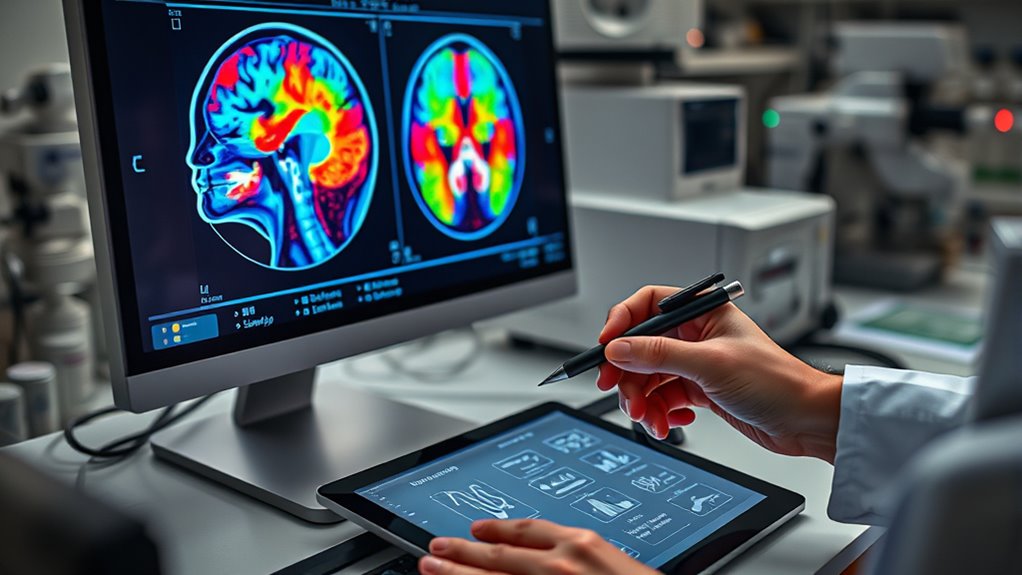
The process of AI-assisted diagnosis begins with acquiring high-quality medical images, which are then processed through sophisticated algorithms that highlight key features. These algorithms analyze the images pixel by pixel, identifying patterns and anomalies that might be difficult for the human eye to detect. Once the features are extracted, the AI system compares them against vast databases of known conditions, using trained models to assess the likelihood of specific diagnoses. The AI then generates a report or probability score, presenting its findings for review. Throughout this process, the system continuously refines its analysis, learning from new data to improve accuracy. This streamlined approach helps clinicians make faster, more informed decisions, ultimately enhancing patient outcomes. Incorporating predictive modeling techniques can further improve diagnostic precision by anticipating disease progression based on imaging data.
Benefits and Challenges of AI in Medical Imaging
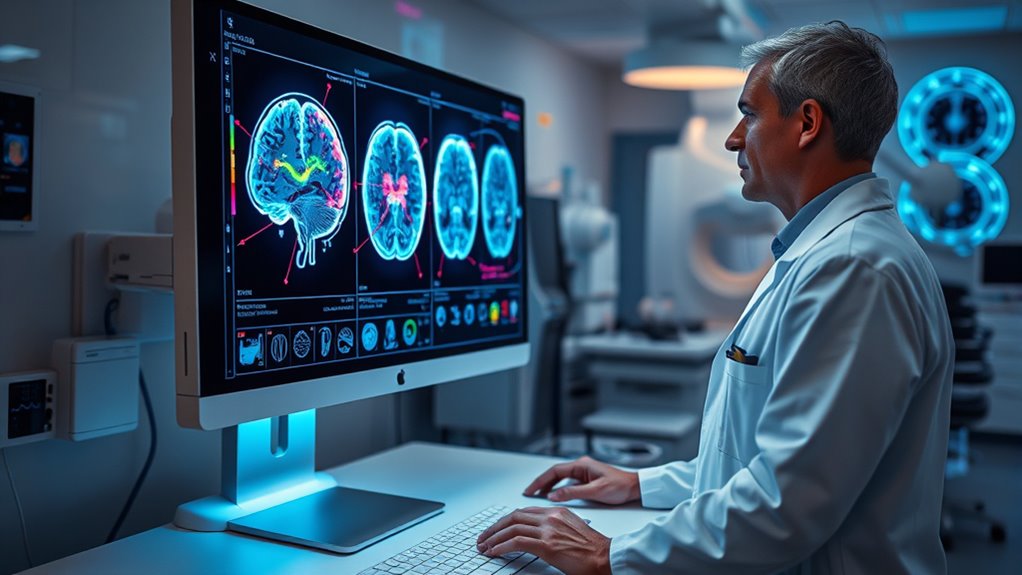
What makes AI a game-changer in medical imaging? It offers faster, more accurate diagnoses, reducing human error and catching issues earlier. You benefit from consistent analysis, especially with large image datasets, which can improve patient outcomes. Additionally, advances in Honda Tuning technologies demonstrate how precise adjustments and data-driven modifications can optimize performance, paralleling how AI fine-tunes diagnostic processes. However, challenges exist. AI systems require vast amounts of high-quality data, and biases in training data can lead to inaccuracies. You also face concerns about transparency—it’s often hard to understand how AI makes decisions. additionally, integrating AI into existing workflows can be costly and complex. Despite these hurdles, the potential for improved efficiency and precision makes AI a powerful tool. Balancing these benefits and challenges is key to maximizing AI’s impact in your medical imaging practice.
Future Directions for AI Diagnostics
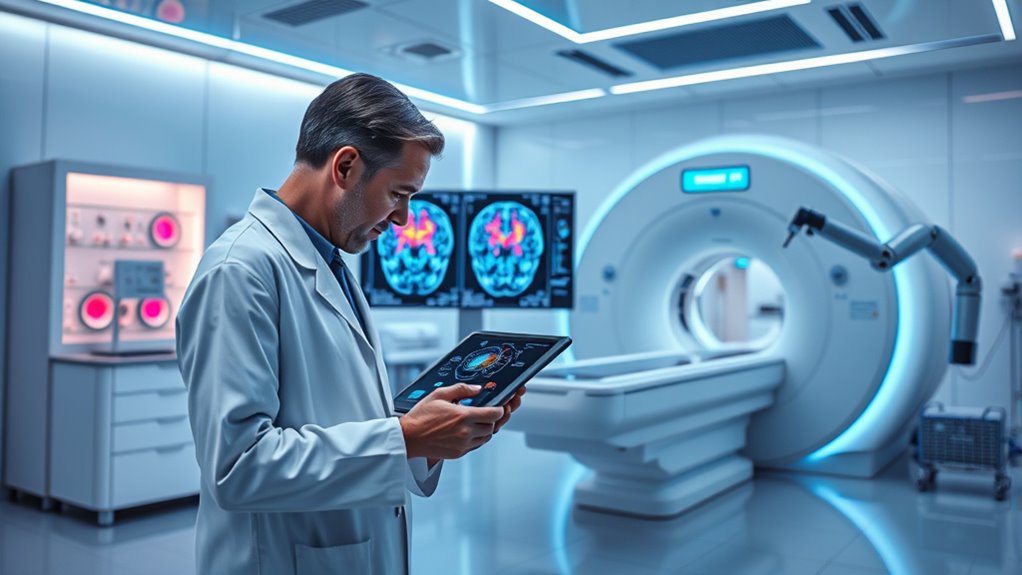
As AI continues to evolve, its future in diagnostics promises even greater precision and integration into clinical workflows. You’ll see AI becoming more proactive, assisting in early detection and personalized treatment plans. Advances in deep learning will enable models to analyze complex data from multiple sources, offering more accurate insights. Expect AI to work seamlessly alongside healthcare providers, streamlining decision-making and reducing errors. Emerging areas like federated learning will enhance data privacy while expanding AI’s capabilities across institutions. Additionally, real-time analysis during scans will improve diagnostic speed and accuracy. You’ll benefit from smarter tools that adapt to individual patient needs, ultimately leading to faster diagnoses, better outcomes, and more efficient healthcare delivery. The future of AI diagnostics is poised to transform medicine profoundly. Ongoing research into AI vulnerabilities will be crucial to ensuring these tools remain trustworthy and secure.
Frequently Asked Questions
How Accurate Are AI Diagnoses Compared to Human Radiologists?
You might wonder how AI diagnoses stack up against human radiologists. Generally, AI systems are quite accurate, often matching or exceeding radiologists in detecting certain conditions like tumors or fractures. They analyze vast amounts of data quickly and consistently. However, AI isn’t infallible; it’s best used as a tool to support, not replace, radiologists, ensuring diagnoses are thorough and accurate.
What Are Common Limitations of AI in Medical Imaging?
Like Icarus flying too close to the sun, AI in medical imaging faces limitations. You might find that AI struggles with rare diseases, making it less reliable for unusual cases. It also depends heavily on the quality of training data, so poor images or biased datasets can lead to errors. Additionally, AI lacks human intuition, which means it can miss subtle signs that a seasoned radiologist would catch.
How Is Patient Data Privacy Maintained During AI Analysis?
You guarantee patient data privacy during AI analysis by implementing strict security measures like encryption and access controls. Data is anonymized so personal identifiers are removed, preventing any link to individual patients. You also follow legal regulations such as HIPAA, which set standards for data protection. Regular audits and secure storage practices further safeguard sensitive information, making sure patient confidentiality remains a top priority throughout the AI process.
Can AI Detect Rare or Unusual Medical Conditions?
You wonder if AI can detect rare or unusual medical conditions. The answer is yes; AI systems are trained on vast datasets, including rare cases, enabling them to identify uncommon patterns that humans might miss. Machine learning algorithms analyze scans and data efficiently, often catching subtle signs of rare conditions. This capability helps doctors diagnose accurately, even in complex or atypical cases, leading to better patient outcomes.
What Regulations Govern AI Use in Healthcare Diagnostics?
Think of healthcare regulations like a sturdy lighthouse guiding your AI tools safely through stormy seas. You need to adhere to laws like HIPAA for patient privacy, FDA approval for medical devices, and data security standards. These rules ensure your AI is accurate, safe, and ethical. Staying compliant helps you avoid legal trouble and builds trust with patients. Keep updated on evolving regulations to navigate this complex landscape smoothly.
Conclusion
So, as you rely more on AI to read scans, remember it’s only as good as the data it’s fed. Ironically, the machines that promise to eliminate human error still depend on human input—and occasional human oversight. While AI may seem to be the future of diagnostics, it’s clear that, for now, you’re still in the driver’s seat, guiding these “intelligent” tools through the complex landscape of medical imaging.
